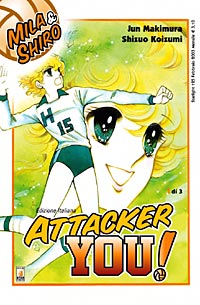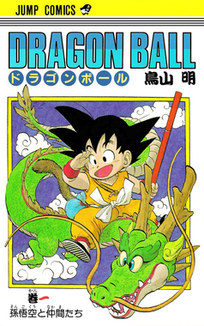 W
W2001 Nights is a science fiction manga series written and illustrated by Yukinobu Hoshino and originally serialized in Futabasha's Monthly Super Action starting from June 1984. It was then collected into three bound volumes by Futabasha, released between August 18, 1985 and October 24, 1986. The series was licensed for an English-language release by Viz Media and published in North America starting in 1990. 2001 Nights is largely inspired by classic hard science fiction, with many visual homages to previous science fiction novels and films.
 W
WA, A Prime is a manga anthology of short stories written and illustrated by Moto Hagio. Originally spelled A, A′, it was first published in November 1984 by Shogakukan and brings together three science fiction stories published between 1981 and 1984. In addition to the titular short story which appeared in Akita Shoten's Princess, the anthology includes "4/4 [Quatre-Quarts]" and "X+Y"—both of which were serialized in the Shogakukan magazine Petit Flower. English translations of the stories, which first appeared separately in Viz Media's Manga Vizion from 1995 to 1996, were collected by the publisher in 1997.
 W
WAttacker You! is a 1984 Japanese manga series by Jun Makimura and Shizuo Koizumi published by Kodansha. An anime series, consisting of 58 episodes of 24 minutes each, was produced by Knack Productions and broadcast by TV Tokyo from April 13, 1984 to June 21, 1985. The DVD version was released in Japan on August 20, 2004.
 W
WBaoh is a Japanese manga series written and illustrated by Hirohiko Araki, most famous for his manga JoJo's Bizarre Adventure. Originally serialized in Weekly Shōnen Jump from 1984 to 1985, it was later compiled into two tankōbon volumes. The series was adapted into a single-episode original video animation (OVA) by Studio Pierrot and distributed by Toho in 1989.
 W
WBarabanba (バラバンバ) is an erotic manga created by Go Nagai. It was originally published by Scola Inc. and serialized in the magazine Scola from October 13, 1983 to August 9, 1984.
 W
WCipher is a shōjo manga series written and illustrated by Minako Narita. It was serialized in Hakusensha's LaLa magazine from the February 1985 issue to the December 1990 issue, and was collected in Japan in twelve tankōbon volumes and seven bunkoban volumes.
 W
WDragon Ball is a Japanese manga series written and illustrated by Akira Toriyama. Originally serialized in Weekly Shōnen Jump magazine from 1984 to 1995, the 519 individual chapters were printed in 42 tankōbon volumes by the publisher Shueisha. Dragon Ball was inspired by the Chinese novel Journey to the West as well as Hong Kong martial arts films. It initially had a comedy focus but later became an action-packed fighting series. The story follows the adventures of Son Goku, from childhood to adulthood, as he trains in martial arts and explores the world in search of the Dragon Balls, seven magical orbs which summon a wish-granting dragon when gathered. Along his journey, Goku makes several friends and battles villains, many of whom also seek the Dragon Balls.
 W
WFuriten-kun (フリテンくん) is a yonkoma manga series by Masashi Ueda which has been serialized in several magazine. In the early 1980s, the manga was published simultaneously in Takeshobo's Kindai Mahjong, Kindai Mahjong Original, and Gamble Punch. It was then published in Manga Life magazine from November 1984 to 1994. The series was started again in January 2001 and is currently running in Manga Life. The title of the series was changed to Shin Furiten-kun (新フリテンくん) in March 2002. The manga was adapted into a theatrical film and an OVA in the early 1980s.
 W
WGod Mazinger , also known as Majin Densetsu (魔神伝説) is an anime, manga and novel series created by manga artist Go Nagai. The anime aired on Japanese TV from April 15, 1984 to September 30, 1984 in the network Nippon Television with 23 episodes. It is given the international title Space Adventure The Deity on the official TMS website. The manga was originally published in tankōbon format by Shogakukan in 4 volumes in 1984. The novelization was published in 1984 and lasted 10 volumes. The three of them share the same basic premise but have a different story.
 W
WHayao Miyazaki's Daydream Data Notes is the collective name for Hayao Miyazaki's annotated manga and illustrated essays he contributed, very sporadically, to the hobby magazine Model Graphix in the 1980s and early ’90s. The name has also been translated into English as Hayao Miyazaki's Random Thoughts Notebook. Game designer Kazuma Kujo stated in a 2012 Retro Gamer article that the book served as inspiration during development of Metal Slug.
 W
WKimagure Orange Road is a Japanese manga series written and illustrated by Izumi Matsumoto. It was serialized in Weekly Shōnen Jump magazine from 1984 to 1987, with the chapters collected into 18 tankōbon volumes by Shueisha. The story follows teenage esper Kyōsuke Kasuga and the love triangle he gets involved in with Madoka Ayukawa, a young heroine with bad publicity who is believed to be a young delinquent, and her best friend Hikaru Hiyama.
 W
WMermaid Saga is a Japanese manga series written and illustrated by Rumiko Takahashi. It consists of 9 stories told in 16 chapters irregularly published in Shogakukan's Shōnen Sunday Zōkan and Weekly Shōnen Sunday from 1984 to 1994.
 W
WPanorama of Hell is a 1984 one shot Japanese horror manga by Hideshi Hino. It was published in the United States by Blast Books and in France as Panorama de l'enfer by Éditions IMHO in 2004.
 W
WPersia, the Magic Fairy is a 48 episode magical girl anime series by Studio Pierrot which aired on Nippon Television from July 1984 to May 1985. In addition to the TV series, two OVAs were released, and the main character, Persia, also appeared in two other Studio Pierrot special presentations. A manga adaptation by Takako Aonuma titled Persia ga Suki! was released at the same time as the anime series. This was the second of five magical girl anime to be created by Studio Pierrot, and featured the character designs of Akemi Takada. Yoshiyuki Kishi, who did the character designs for Pierrot's next magical girl series Magical Emi, the Magic Star, is also credited as the series's character designer and animation director.
 W
WPurple Eyes in the Dark is a Japanese shōjo manga series written and illustrated by Chie Shinohara. It was serialized in Shōjo Comic magazine from 1984 to 1986. The individual chapters were collected in 12 tankōbon volumes published by Shogakukan between October 1984 and February 1987. The story follows the struggles of a teenage girl after she finds herself turning into a lycanthropy-leopard and having to battle her newly found predatory instincts.
 W
WUltra B is a manga series by Fujiko A. Fujio that first made its debut in Chuokoron-Shinsha's Fujiko Fujio Land series of tankōbon books in 1984 and was released in individual tankōbon until 1989. In 1987, the manga was adapted into a 120-episode anime of the same name by Shin-Ei Animation which aired on TV Asahi from 4 April 1987 to 27 March 1989. It is inspired by Doraemon.
 W
WUtsunoMiko (宇宙皇子), also written Utsu no Miko, is a Japanese historical fantasy light novel series written by Keisuke Fujikawa (藤川桂介) and illustrated by Mutsumi Inomata, which was later adapted into an anime of the same title. The story is set in the late Asuka Period to the Nara Period, and follows the trials of the title character Utsunomiko, the offspring of the kami of the north star. There are 52 Utsunomiko novels, the first published in 1984, and the last published in 1998. The Utsunomiko movie premiered in 1989, followed by a second movie and a 13-episode OVA starting in 1990.
 W
WWhat's Michael? is a Japanese manga series created by Makoto Kobayashi. In 1984, it began its serialization in the Weekly Morning magazine. The manga shows Michael, an orange American Shorthair tabby cat, his feline friends, and other domesticated pets in a series of humorous episodes. Michael is not a specific cat, but rather a feline version of the everyman as he appeared in drastically different settings across chapters: he's a normal cat in some chapters, an anthropomorphic cat in others, and he even dies in some chapters. Dark Horse Comics released the series in the US as eleven volumes between 1997 and 2006, and in 2020 released the first volume of a "Fatcat Collection", which spanned the first six volumes. The manga was presented in the standard left to right American reading format.